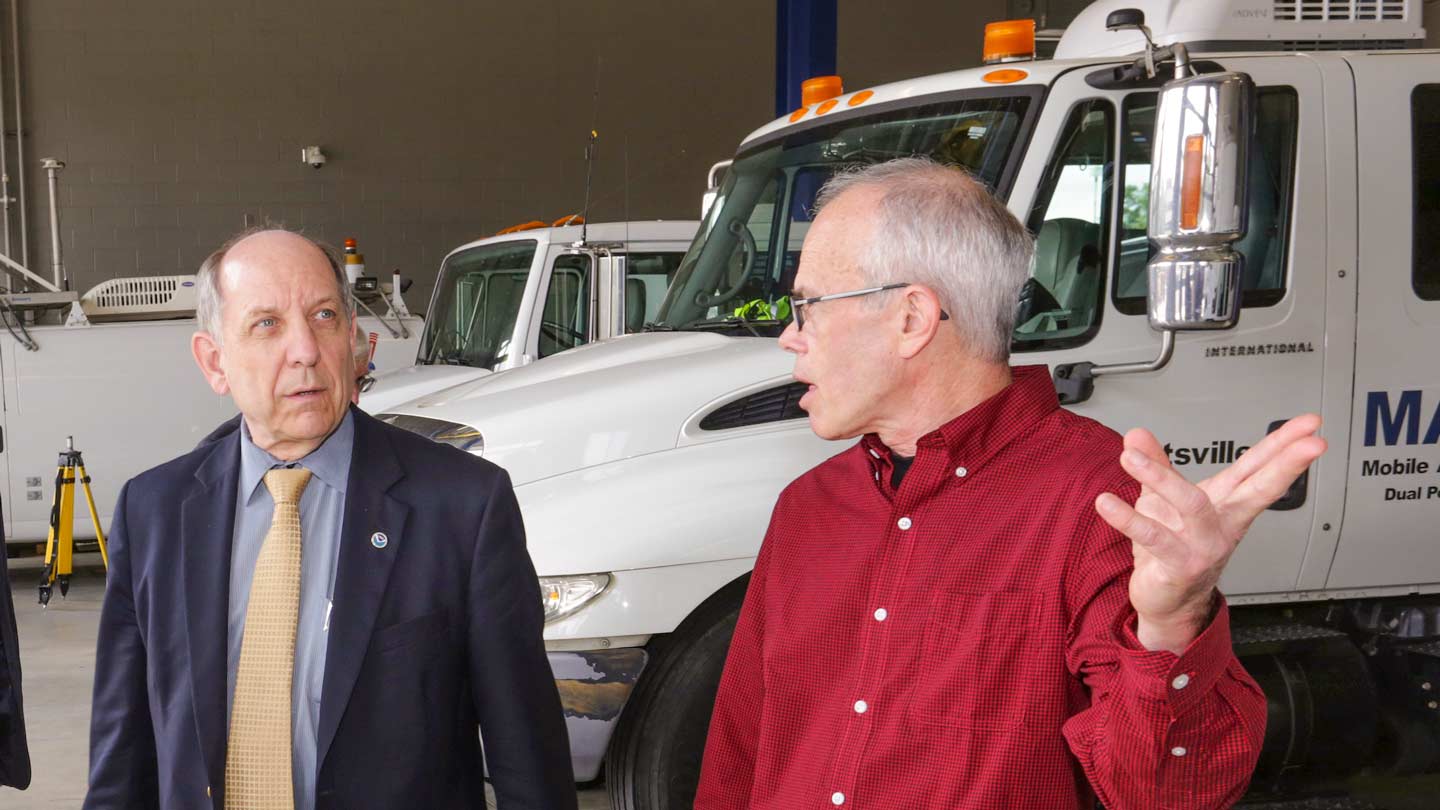
Dr Kevin Knupp, right, with Dr. Louis Uccellini, director of the National Weather Service (NWS) and National Oceanic and Atmospheric Administration (NOAA) assistant administrator for Weather Services, during a recent tour of UAH’s SWIRLL facility.
Michael Mercier | UAH
The University of Alabama in Huntsville (UAH) is a new member of a cooperative Gulf of Mexico region institute that has just received a $7 million award
from the National Oceanic and Atmospheric Administration (NOAA) to continue its ecosystem work.
UAH was invited to join the Northern Gulf Institute (NGI), which has been a NOAA cooperative institute
for the last decade and includes Mississippi State University as the lead, plus other members including the University of Southern Mississippi, Florida
State University, Louisiana State University and Dauphin Island Sea Lab.
"An advantage of being a member of a cooperative institute is that you have a direct link to NOAA labs," says Dr. Kevin Knupp, a professor of atmospheric
science. "It gives us the opportunity to more easily develop proposals and get funding."
The NOAA award funds the first year of a five-year award that can then be renewed for another five years based on successful performance. NOAA made its
selection after an open competition prompted by the expiration of NGI's current award in September. In its successful proposal, NGI has committed to expand
its research to encompass the entire Gulf of Mexico region.
NGI will focus on research in four thematic areas to help create more resilient ecosystems, communities and economies for the region:
- Climate change and climate variability effects on regional ecosystems
- Coastal hazards
-
Ecosystem management
- Effective and efficient data management systems to support a data-driven economy
NGI will address research gaps such as improving technologies to sample fish stocks in challenging environments, developing methods to improve large-scale
data integration and dissemination, improving habitat restoration and coastal resiliency by determining the impacts of climate change on coastal areas and
studying how algal blooms affect ecosystem health.
UAH's areas of expertise and research collaborations are a good fit, Dr. Knupp says.
"You bring us in and you bring in connections to NASA's SpoRT and NASA's SEVIR, because
we are associated with those," he says.
SPoRT is the NASA Short-term Prediction Research and Transition project that transitions unique observations and research capabilities to the operational
weather community to improve short-term weather forecasts on a regional and local scale. SERVIR is a joint development initiative of NASA and USAID,
working in partnership with leading regional organizations at SERVIR hubs around the globe to help developing countries use information provided by Earth
observing satellites and geospatial technologies for managing climate risks and land use.
"Coastal hazards is where we fit in most directly," Dr. Knupp says. Those include the effects of land-falling hurricanes on the overall marine and land
environment, as well as on plants, sea creatures and other wildlife.
"The other area where we can be of help is air quality," he says, citing the impacts of ozone and the oil industry on the gulf region's air as possible
areas of study. "We could look at what bad are constituents are generated on the continent that could affect the coastal areas."
Helping with the air quality portion of the NOAA proposal were Dr. Mike Newchurch, professor of atmospheric science, Dr. Shanhu Lee, associate professor of
atmospheric science, and Dr. Arastoo Biazar, a research scientist with the Earth System Science Center.
NGI may also be a good fit for proposals under the VORTEX-SE program, a research project coordinated by NOAA's National Severe Storms Laboratory that's
trying to understand how environmental factors characteristic of the Southeastern United States affect the formation, intensity, structure and path of
tornadoes. Dr. Knupp said he is working on a UAH VORTEX-SE proposal involving NGI now.
"There are opportunities to develop multidisciplinary scientific endeavors because of the diversity of institutions that make up NGI," he says. "That opens
the door for everybody in atmospheric science and Earth system science to do these types of NOAA collaborations."
NOAA's Cooperative Institute (CI) Program
is a unique and powerful tool designed to address emerging research and development needs of NOAA's mission.
"Our cooperative institutes provide real partnership, expertise and flexibility, which is very important in achieving NOAA's mission," says Craig McLean,
NOAA's assistant administrator for NOAA Research. "They provide a talented body of scientists, diverse thinking and nimble responsiveness to our needs
while helping to train the next generation of researchers."
NOAA supports 16 cooperative institutes consisting of 42 universities and research institutions across 23 states and the District of Columbia. These
research institutions provide strong educational programs that promote student and postdoctoral scientist involvement in NOAA-funded research.